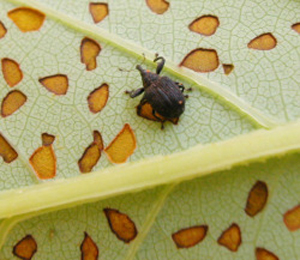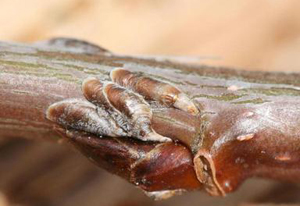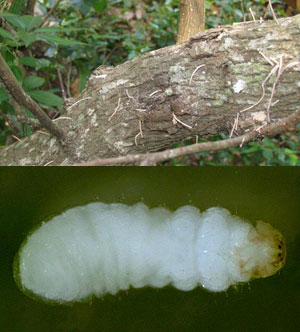Leaf Feeders

Lee Townsend, University of Kentucky Entomology
Sassafras weevils, also known as yellow poplar weevils, or magnolia weevils, are small black snout beetles that occasionally damage yellow poplar, sassafras, and magnolia. Adults chew distinctive holes in the leaves that resemble curved rice grains in size and shape. The combined activity of adults and larvae can cause significant leaf loss. While injured leaves cause the trees to be unsightly, damage to established trees probably does not affect its overall health. Occasionally there are large outbreaks.

Lee Townsend, University of Kentucky
Japanese beetles can feed on about 300 species of plants ranging from roses to poison ivy but basswood is one of their favorites. They usually feed in groups, starting at the top of the tree and working downward, and prefer plants that are exposed to direct sunlight. A single beetle does not eat much; it is group feeding by many beetles that causes severe damage. Adults feed on the upper surface of foliage, chewing out tissue between the veins. This gives the leaf a characteristic skeletonized appearance. For more information, see Entfact 451.
Sap Feeders

Whitney Cranshaw, Colorado State University, Bugwood.org
Oystershell scales are about 1/10 inch long and resemble crusty accumulations of oyster shells on the bark. Their drab, bark-like appearance makes them easy to overlook, even on close inspection. Heavy infestations can kill twigs or branches. This scale overwinters in the egg stage under the waxy covering of the female. The eggs hatch and the crawlers are active from late May to early June.
Borers

damage: Albert (Bud) Mayfield, USDA Forest Service, Bugwood.org;
larva: Andrew Derksen, USDA-APHIS, Bugwood.org
Redbay ambrosia beetle is an invasive species that is notable for vectoring the pathogens responsible for laurel wilt. As adults they are about 1/8 inch long, dark in color, and have small dents over parts of their body. They can be hard to identify without the help of an expert. Larvae are also small, but are white, legless grubs with reddish orange head capsules. Adult beetles transport fungi that they will "farm" in the tissue of plants. Symptoms of infestation include small (1/16 inch diameter) exit holes in the bark, as well as toothpick like structures made up of sawdust.